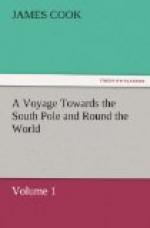We kept between the latitude of 52 deg. and 53 deg. S., had much westerly wind, hard gales, with squalls, snow and sleet, with a long hollow sea from the S.W., so that we judged there is no land in that quarter. After we reached the longitude of 95 deg. E., we found the variation decrease very fast.
On the 26th, at night, we saw a meteor of uncommon brightness in the N.N.W. It directed its course to the S.W., with a very great light in the southern sky, such as is known to the northward by the name of Aurora Borealis, or Northern Lights. We saw the light for several nights running; and, what is remarkable, we saw but one ice island after we parted company with the Resolution, till our making land, though we were most of the time two or three degrees to the southward of the latitude we first saw it in. We were daily attended by great numbers of sea birds, and frequently saw porpoises curiously spotted white and black.
1773 March
On the 1st of March we were alarmed with the cry of land by the man at the mast-head, on the larboard beam; which gave us great joy. We immediately hauled our wind and stood for it, but to our mortification were disappointed in a few hours; for, what we took to be land, proved no more than clouds, which disappeared as we sailed towards them. We then bore away, and directed our course towards the land laid down in the charts by the name of Van Diemen’s Land, discovered by Tasman in 1642, and laid down in the latitude 44 deg. S., and longitude 140 deg. E., and supposed to join to New Holland.
On the 9th of March, having little wind and pleasant weather, about nine a. m. being then in the latitude of 43 deg. 37’ S. longitude, by lunar observation, 145 deg. 36’ E., and by account 143 deg. 10’ E. from Greenwich, we saw the land bearing N.N.E., about eight or nine leagues distance. It appeared moderately high, and uneven near the sea; the hills farther back formed a double land, and much higher. There seemed to be several islands, or broken land, to the N.W., as the shore trenched; but by reason of clouds that hung over them, we could not be certain whether they did not join to the main. We hauled immediately up for it, and by noon were within three or four leagues of it. A point much like the Ramhead off Plymouth, which I take to be the same that Tasman calls South Cape, bore north four leagues off us. The land from this cape runs directly to the eastward; about four leagues along shore are three islands about two miles long, and several rocks, resembling the Mewstone, (particularly one which we so named,) about four or five leagues E.S.E 1/2 E. off the above cape, which Tasman has not mentioned, or laid down in his draughts. After you pass these islands, the land lies E. by N., and W. by S., by the compass nearly. It is a bold shore, and seems to afford several bays or anchoring-places, but believe deep water. From the S.W. cape, which is in the latitude of 43 deg. 39’ S., and longitude 145




